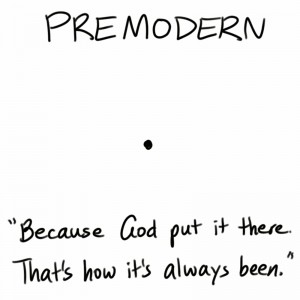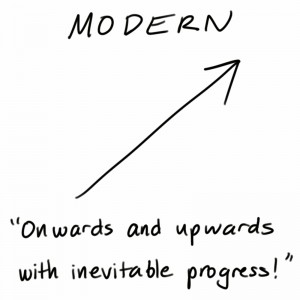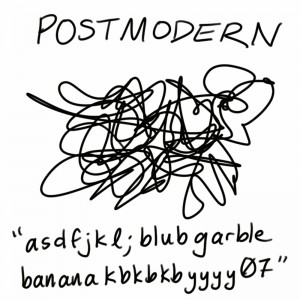Postmodernism: a (reluctant) historical progression
Postmodernism may be impossible to define, but this does not provide an excuse for avoiding attempts to articulate or understand it further. The postmodern refusal of clear definitions makes it tricky to talk about what the word "postmodernism" "means," since a postmodernist treatment of "meaning" denies a singular meaning that can be found in absolute or stable form. However, a postmodernist treatment of meaning does acknowledge that meaning exists, and that it can be constructed, found, and played with by looking at the relationships of the thing ("sign") at hand (the one you're investigating the meaning of) and other things. Therefore, in this section, I will position postmodernism relative to other viewpoints that might be historically familiar to engineering readers, with the intent of providing more material with which readers and I can employ to make sense of the concept.
As its name implies, postmodernism is a movement which grew in response to modernism. It is therefore instructive to look at the philosophical paradigms of premodernism and modernism in order to see postmodernism's relationship relative to both. The image below provides an overview: premodernism viewed reality as static and predetermined, modernism brought with it an emphasis on continuous progress in the name of human liberation, and postmodernism questioned modernism's relentless pursuit of that notion of "progress" while inquiring what, exactly, "progress" might mean. (Note to blog readers: the images below are from an earlier blog post and I would love ideas on how to do a decent text description of this for screenreaders and so forth, or whether such a description is redundant with the explanation below.)



Prior to the 19th century, premodern (or sometimes "romantic") viewpoints were widespread across Westernized societies such as the US; such a viewpoint viewed the world as ordered by divine and governmental authority, and a human's role within that world to be pre-ordained by the circumstances of their birth. In other words, if your parents were farmers, you would probably be a farmer, because that was the will of God; one's identity was fixed.
Modernism came of age during the time of the Industrial Revolution, revolting against the notion of a fixed identity. The importance of the individual and the "sovereign self" that could determine its own destiny was reflected in narratives about self-starting bootstrappers who pursued "The American Dream" and went from rags to riches. This notion of identity developed in parallel with the rapid development of technologies that made the average 19th and 20th century American's life dramatically different from their parents, and the narrative of constant economic, technological, and social progress. With modernist thinking, the stock market would always go up in the long term; transistor density (and thus computing power) would always become smaller and cheaper (Moore's law), and humankind was on an inevitable trajectory towards upwards and measurable progress.
Simulaneously, in the biological sciences, Darwin's theory of evolution also provided a narrative of ongoing progress that was literally encoded into the nature of humans and the world around them (Darwin, 1859). Scientific quests for knowledge and betterment, and a belief in progress and perfectability became highlights of a modernist way of thinking. Also associated with modernism and its philosophy of science was structuralism, a movement associated with linguistics which emphasized the search for underlying structure and facts and presupposed the existence of such structures and absolute facts. (Ward, 1996, p. 86-104).
The "postmodern turn" pushed back against modernist assumptions with the challenge that there are no facts, only interpretations. Whereas modernist and structuralist thought emphasized the finding of intrinsic meaning and truth and the categorization and increasingly fine-grained naming of things in order to further optimize society's understanding and evolution, postmodernism questioned its incessant gaze towards those goals. Whereas modernism and structuralism enshrine the primacy of individual choice and upwards progress, postmodernism questions these assumptions. What does "better" mean, and who gets to decide it? What are the boundaries of an individual, and why is it so important to separate people into stable units of analysis? A modernist pursuit on measurable progress requires trackable units of measurement (students with grades, countries with GDP, etc.) whereas a postmodern query asks: why do we use these particular methods of measuring and meting out?
Postmodernism is a response to the modernist emphasis on unrelenting "progress" towards a "better" world that interrogates the assumptions and power structures behind those terms and asks how they might be otherwise. Correspondingly, the postmodern inquirer’s work is not towards the increasingly “better” articulation of knowledge and truth which they are attempting ot teach their audience. “The postmodern text is evocative as opposed to didactic; extended argument is displaced... [in favor of] pastiche, montage, collage, bricolage, and the deliberate conglomerizing of purposes [that] characterize postmodern art and architectural styles” (Lather, 1991, p. 10). By questioning the very concept of a single, infinitely extendable "better" and the promise of certainty that the grand, sweeping narrative of continuous improvement and the search for truth and meaning offers, postmodernism exemplifies an "incredulity towards metanarratives," or totalizing narratives that exclude the search for other explanations (Lyotard, 1984, p. xxiv). The postmodern movement, or "turn," is deeply steeped in such refusals to settle, opting instead for the constant motion of "keeping meaning at play" (Jackson and Mazzei, 2012, p. 70-71).
For a further discussion of the historical relationships between premodernism, modernism, and postmodernism, a reasonable starting progression might be to consult Tierney (1993) for a brief and self-admittedly oversimplified historical retrospective, Lyotard's classic "The Postmodern Condition" (1984) for one of the seminal first attempts by a postmodernist to explain postmodernism to the world, or "The Postmodern Turn" (Best, 1997) for one comprehensive historical look at the postmodern movement across disciplines alongside Cavallaro's "Critical and Cultural Theory: Thematic Variations" (2001) which provides a brief, encyclopedic-style introduction to relatively up-to-date discussions of key concepts in postmodern thought.